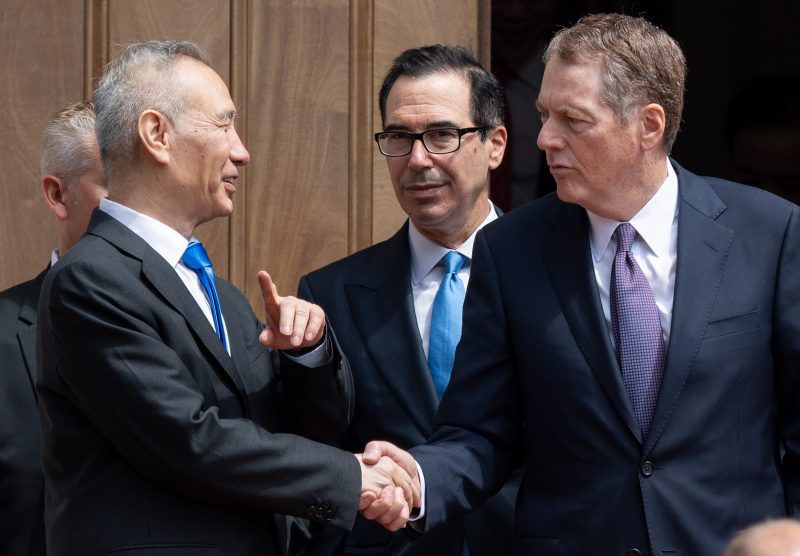Trump orders tariff hike on remaining Chinese imports
Chinese Vice Premier Liu He (L) shakes hands with US Trade Representative Robert Lighthizer (R) alongside US Treasury Secretary Steven Mnuchin (C) following two hours of negotiations (SAUL LOEB)
Washington (AFP) – US President Donald Trump cranked up the heat Friday in a trade battle with China, ordering a tariff hike on almost all remaining imports from the world’s second-biggest economy, putting at risk global growth and the stability of financial markets.
After tweeting that two days of trade talks in Washington had been “candid and constructive,” the businessman-turned-politician changed tack and followed through on a threat he had been making for months.
“The President… ordered us to begin the process of raising tariffs on essentially all remaining imports from China, which are valued at approximately $300 billion,” US Trade Representative Robert Lighthizer said in a statement.
The move came less than 24 hours after Washington increased punitive duties on $200 billion worth of Chinese imports, raising them to 25 percent from 10 percent.
Details on the process for public notice and comment will be posted Monday, ahead of a final decision on the new tariffs, Lighthizer said. They were not expected to go into effect for several months.
Beijing responded by vowing to take the “necessary countermeasures.”
The developments came as two days of talks to resolve the trade battle ended Friday with no deal, but no breakdown either, offering a glimmer of hope that Washington and Beijing could find a way to avert damage to the global economy.
“Over the course of the past two days, the United States and China have held candid and constructive conversations on the status of the trade relationship between both countries,” Trump tweeted.
“The relationship between President Xi and myself remains a very strong one, and conversations into the future will continue.”
The tariffs on China “may or may not be removed depending on what happens with respect to future negotiations!”
Chinese Vice Premier Liu He told reporters that the talks had gone “fairly well,” according to Bloomberg.
The seemingly positive messages — coming before the announcement that Trump had ordered the latest round of tariffs — had cheered Wall Street, which had been under pressure all week. The benchmark Dow Jones Industrial Average recovered from a loss of nearly 350 points to close with a gain of 117 points.
US Treasury Secretary Steven Mnuchin and Lighthizer met for about two hours with Liu on Friday and then headed for the White House to brief Trump, who had said he was in no hurry to reach a deal, arguing the United States was negotiating from a position of strength.
– From anger to hope –
Trump began the standoff because of complaints about unfair Chinese trade practices. The United States is pressing China to change its policies on protections for intellectual property, as well as massive subsidies for state-owned firms, and to reduce the yawning trade deficit.
After weeks of rising optimism about the chances for an agreement, the tone out of the White House has veered from anger to nonchalance.
On May 5, Trump erupted on Twitter, saying the talks were progressing “too slowly,” accusing the Chinese of backing out of commitments and announcing the tariff increase.
But in a series of early morning tweets Friday, he said there was “absolutely no need to rush.”
The US leader continues to argue that tariffs could in some ways be preferable to reaching a trade deal.
“Tariffs will bring in FAR MORE wealth to our country than even a phenomenal deal of the traditional kind,” Trump wrote.
Economists stress that duties are paid by US companies and consumers and result in higher prices, while farmers and manufacturers complain about the loss of markets for their exports due to retaliation from China and other targets of Trump’s trade wrath.
– ‘No one wins’ –
“NO ONE WINS A TRADE WAR,” trade analyst Chad Bown of the Peterson Institute for International Economics said on Twitter.
Since last year the United States and China have exchanged tariffs on more than $360 billion in two-way trade, gutting US agricultural exports to China and weighing on both countries’ manufacturing sectors.
The higher duty rates imposed on Friday will hit a vast array of Chinese-made electrical equipment, machinery, auto parts and furniture.
“While we are disappointed that the stakes have been raised, we nevertheless support the ongoing effort by both sides to reach agreement on a strong, enforceable deal that resolves the fundamental, structural issues our members have long faced in China,” said the American Chamber of Commerce in China.
Oxford Economics estimates the “tariff punch” from all existing duties will cut 0.3 percentage points off US growth and warns recession risks are on the rise. Economists in China estimate a similar impact.
The International Monetary Fund has warned the conflict and the loss of confidence it creates will have a wider impact on the global economy and is a major risk to growth.
Disclaimer: Validity of the above story is for 7 Days from original date of publishing. Source: AFP.


